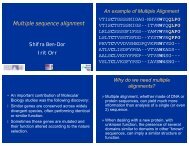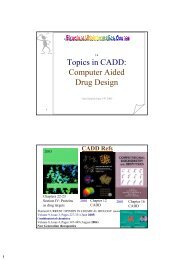Introduction to Phylogenetic Analysis
Introduction to Phylogenetic Analysis
Introduction to Phylogenetic Analysis
You also want an ePaper? Increase the reach of your titles
YUMPU automatically turns print PDFs into web optimized ePapers that Google loves.
Kimura two-parameter model<br />
This model assumes that transitions<br />
(A - G or T - C) occur more often than<br />
transversions (purine -pyrimidine).<br />
A<br />
C<br />
α<br />
α<br />
G<br />
T<br />
α<br />
Is the rate of transitional<br />
Substitutions.<br />
β<br />
β<br />
β Is the rate of transversional<br />
substitutions.<br />
DNA Evolution Models<br />
A basic process in DNA sequence<br />
evolution is the substitution of one<br />
nucleotide with another.<br />
This process is slow and can not be<br />
observed directly.<br />
The study of DNA changes is used <strong>to</strong><br />
estimate the rate of evolution, and the<br />
evolution his<strong>to</strong>ry of organisms.<br />
These evolutionary models improve the<br />
distance calculations between the<br />
sequences.<br />
These evolutionary models have less<br />
effect in phylogenetic predictions of<br />
closely related sequences.<br />
These evolutionary models have better<br />
effect with distant related sequences.<br />
rat<br />
goldfish<br />
zebrafish<br />
Xeno<br />
bovine<br />
human<br />
How <strong>to</strong> read the tree?<br />
Start at the base and follow<br />
The progression of the branch<br />
points (nodes)











